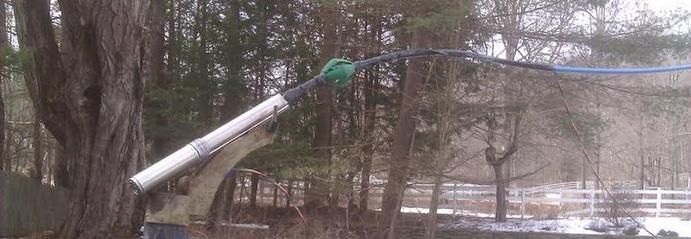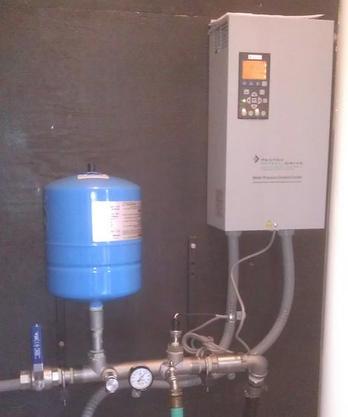Valley Artesian Well Co., Inc
Call Us for More Information or a Free Estimate:
802.674.6493
6428 Route 5 Ascutney, Vermont
Water Pump Systems
With a well, you have two options for submersible pump systems. There is the traditional standard pump system which operates from a pressure switch, large pressure tank and usually a control box. Or with newer technology there are now Variable Frequency Drives which can speed up or slow down the pump in order to deliver constant, consistent pressure with a small tank, no switch and a drive that replaces the control box.
Standard Water System: Once a well is drilled and has adequate water supply, we can then think about options for how to pump the water to your house. You will have a water system installed that has some options. All systems begin with a submersible pump that will be installed towards the bottom of the well on either galvanized steel pipe or plastic “poly” pipe. Along with the pipe will be the wire necessary to deliver power to the motor of the pump. About 5‘-6’ below ground level, as long as bedrock is deep enough to allow, there will be a fitting called a pitless adapter which allows water to exit the well and flow into a pipe that heads towards the building. The pitless adapter is a two piece fitting. One piece is secured to the casing, after a hole is appropriately cut, with a rubber gasket to ensure a water tight seal. The other piece stays inside the well and is how the pump can be serviced in the future. Once on the outside, water will travel through pipe into the building. Once inside the building, there will be a pressure tank and a set of controls. The size of the tank can vary greatly depending on demand and the style of controls. The standard size tank for single family residences is a 32-35 gal. pressure tank. Some multi-family residences or commercial applications can use tanks much larger and even multiple tanks to keep the pressure as even as possible and allow proper run time for the pump. Why is this important? When the pump first starts it builds up some heat in the motor. Since it’s submerged in water, it relies on the cool water being drawn past the motor to cool it down. If a pump can’t run long enough or starts too often it can build up a lot of heat in the motor, shortening the life span of the pump. Sometimes it will take out a control box before the pump. The control box is a device with a capacitor and relay that helps jump start the pump. The other component to the standard pump system is the pressure switch. The switch is the device that regulates the operating pressure of the system. It has a spring and paddle that work together to close a set of contacts supplying power to the control box which in turn goes to the pump, or disengages the contacts when the pressure is sufficient.
Constant Pressure System: The alternative to the standard pump system is called a constant pressure system. This involves newer technology. We still use most of the same materials in the well and to the house, the difference is inside the home. Instead of big pressure tanks, a pressure switch and a control box we can use a variable frequency drive (V.F.D.) with a transducer and a small 4 gal. pressure tank. The V.F.D. controls the power that is sent to the pump. It can stutter the hertz that are sent to the pump, allowing the pump to run at different speeds. Since the pump will be able to run at different speeds it can deliver as much or as little water as is necessary to maintain a steady, constant pressure at say 60 p.s.i. instead of a switch that varies from 30-50 p.s.i. or 40-60 p.s.i. As an additional benefit to the constant pressure, when you are not using a lot of water, i.e. brushing your teeth or washing your hands, the pump will not have to run at full power, therefore not using as much electricity. Depending on how much water you use depends on how much energy you will save. The V.F.D. also has many other benefits. These drives will monitor incoming power, so if your power input is too high or not sufficient it won’t allow the pump to run until the power is within appropriate parameters. If parameters aren’t correct it will automatically check back every few minutes to try to run and build pressure again. They also monitor the water pressure in case you have a leak, like an overflowing toilet or a garden hose that got left on by mistake. If the system runs for 24 consecutive hours the drive assumes there is a leak and will turn off to notify you there is a problem. If your well doesn’t make a lot of water and you run dry, the drive is smart enough to recognize it and automatically cut off power to pump for pre-determined times up to three times to allow the well to recover. After each of the rest periods it will automatically re supply the pump with power to restore water if possible. Those are most of the benefits of having a Variable Frequency Drive.
Service in the Future: What do I do if I have problems down the road? There are several possible issues that can happen to a well pump system. Troubleshooting a pump system is a process of elimination. There are three basic aspects we can test for, voltage, ohms, and amps. If any one of those three functions aren’t working properly, you don’t have water. We have the proper equipment to diagnose and fix the problem(s). There are always “unforeseen circumstances” that can happen with service calls, but most always we can have you back in water the same day you call or the next day. You don’t always have to be out of water to have issues with your water system. Sometimes there are “warning” signs that your system is about to fail but hasn’t yet. For example, if your water pressure seems to surge, pressure is great, then dies down, then great…etc, you have an issue with your pressure tank. Inside your pressure tank there is a diaphragm that separates the air in the top half from the water. In time all bladders will eventually tear, usually near 20 years with a quality tank. When water replaces the air, you will get surging. When you notice the surging, you need to replace the tank. If you wait too long you will create more problems. When the pump cycles are shortened it builds up more and more heat with each start. It may take weeks or even a couple months to build up enough heat to finally burn out the motor, but if and when it does, you will have to change the pump and the tank. With all the starting and stopping due to short cycling, the pump will have a lot of movement inside the well creating the opportunity for wires to chafe against the bedrock. If the wires chafe enough it can break through the insulation causing a short or eventually a break in the wires. That means no water for you and a pump setting for us to pull and reset, with our machine. Not all problems require the pump to be pulled, sometimes it can simply be a control box or a pressure switch.
Well Drilling Water Quality Testing 365 Day Service
Geothermal Drilling Water Softeners Complete Pump Systems
IGSPHA- AI Certification Iron/Rust Filters Constant Pressure Systems
Hydro-Fracturing Sulphur/Odor Filters Well Inspections
Irrigation Wells Ph Neutralizers In-Well Video Inspections
Pond Wells Reverse Osmosis Units Casing Weld Extensions
Well Abandonment Radon Filters Code Updates



